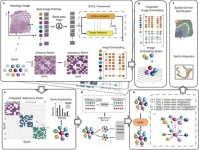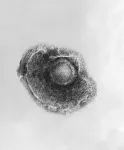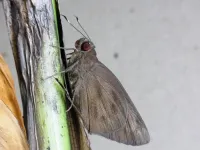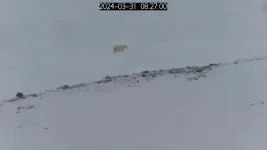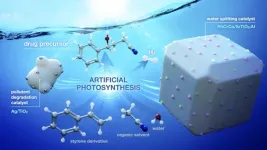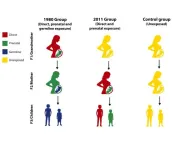Four research teams rethink particleboard construction and reuse
2025-02-27
(Press-News.org) For a few hundred dollars, a bedroom can be refreshed with the latest flat-pack offerings. Wood particleboard furniture is affordable and generally easy to assemble, but particleboard is often held together with formaldehyde-based resins that make it hard or impossible to recycle. Now, with the help of science, old pressed-wood furnishings could be repurposed, and new modular decor could incorporate more environmentally friendly materials. Four articles published in ACS journals reveal how. Reporters can request free access to these papers by emailing newsroom@acs.org.
1. Adhesive-free particleboard joined by plant fibers. To bind wood chips together in particleboard, resins containing formaldehyde alternatives have been proposed, such as lignin or cellulose. Now, researchers reporting in ACS’ Nano Letters have developed plant macrofibers with tiny nanofibers on their surfaces (like pieces of yarn that have been roughed up) to ensnare and link the wood chips together. In demonstrations, particleboard made with the new macrofibers was strong, sound-absorbing and lighter than particleboard made with the other plant-based alternative resins.
2. Self-bonding bamboo fiberboard. Researchers in ACS Sustainable Chemistry & Engineering have developed a specialized bamboo fiber that forms a self-bonding fiberboard. Made from fast-growing bamboo, the board is strong and flexible, and it doesn’t use formaldehyde or other volatile organic compounds as a binder. The new material is held together by treating the bamboo fibers with tea polyphenols and cobalt ions, and then cross-linking the fibers’ hydroxyl and carboxyl functional groups with heat and pressure.
3. Thermal insulation made from cardboard. Thermal insulation for buildings is typically made from petrochemical-based polymers, such as polystyrene and polyurethane. Now, a study published in ACS Nano proposes a renewable foam made from discarded cardboard. The foam, manufactured with what the researchers call a one-pot synthesis strategy, is lightweight, temperature insulating and fire-resistant. These characteristics suggest the material could be an effective and sustainable insulation option for residential buildings.
4. Repairing joints with recycled wood. In an ACS Nano study, researchers propose using discarded wood materials, such as particleboard, to create hydrogels with mechanical properties similar to cartilage for the repair of joint defects and injuries. Demonstrations of the wood-derived hydrogel in animal models showed that it healed osteochondral injuries in femur joints significantly better than joints treated with traditional collagen gels at 12 weeks after injury onset. To the researchers’ knowledge, this is the first study investigating the use of wood in tissue engineering.
###
The American Chemical Society (ACS) is a nonprofit organization founded in 1876 and chartered by the U.S. Congress. ACS is committed to improving all lives through the transforming power of chemistry. Its mission is to advance scientific knowledge, empower a global community and champion scientific integrity, and its vision is a world built on science. The Society is a global leader in promoting excellence in science education and providing access to chemistry-related information and research through its multiple research solutions, peer-reviewed journals, scientific conferences, e-books and weekly news periodical Chemical & Engineering News. ACS journals are among the most cited, most trusted and most read within the scientific literature; however, ACS itself does not conduct chemical research. As a leader in scientific information solutions, its CAS division partners with global innovators to accelerate breakthroughs by curating, connecting and analyzing the world’s scientific knowledge. ACS’ main offices are in Washington, D.C., and Columbus, Ohio.
Registered journalists can subscribe to the ACS journalist news portal on EurekAlert! to access embargoed and public science press releases. For media inquiries, contact newsroom@acs.org.
Note: ACS does not conduct research but publishes and publicizes peer-reviewed scientific studies.
Follow us: Facebook | LinkedIn | Instagram
END
ELSE PRESS RELEASES FROM THIS DATE:
2025-02-27
Biological tissues are made up of different cell types arranged in specific patterns, which are essential to their proper functioning. Understanding these spatial arrangements is important when studying how cells interact and respond to changes in their environment, as well as the intricacies of pathologies like cancer. Spatial transcriptomics (ST) techniques, which have been rapidly evolving over the past decade, allow scientists to map gene activity within tissues while keeping their structure intact, ...
2025-02-27
The varicella zoster virus (VZV), an infectious virus from the herpes virus family, is primarily known to cause varicella in children and shingles in adults. But lately, this virus has also been reported to trigger severe complications like central nervous system (CNS) infections. Researchers from Fujita Health University, Japan, conducted a comprehensive study spanning 10 years (2013–2022), to identify the VZV-related infections affecting the CNS. Their study reveals a marked increase in adult VZV-related CNS infections, ...
2025-02-27
CABI has led a team of scientists who have used DNA barcodes to narrow down the possible sources of introductions of an invasive banana skipper butterfly, with implications as to the threat of it spreading to Africa and tropical America.
The banana skipper, Erionota torus Evans (Lepidoptera, Hesperiidae, Hesperiinae, Erionotini) is a South-east Asian pest of banana that, in the last 60 years, has spread to the southern Philippines, Taiwan, Japan, India, Sri Lanka, Mauritius and La Réunion.
The new research, published in the journal CABI Agriculture and Bioscience, analysed a partial library of DNA barcodes from the indigenous and introduced ranges and suggests that aircraft are likely ...
2025-02-27
Global partnerships that embed scientific research into clinical care are revolutionising the diagnosis and treatments for children with rare genetic diseases, according to a new report.
The white paper found despite advances in genomic technologies, which can detect rare genetic diseases within days, there remained significant challenges to ensuring this leads to improved child health outcomes. But global collaborations, such as the International Precision Child Health Partnership (IPCHiP), using evidence-based approaches to inform decisions in real-time, are overhauling patient care.
The paper was led by Murdoch Children’s Research Institute (MCRI), The Hospital for Sick ...
2025-02-27
Svalbard, Norway – February 27, 2025 – Researchers from Polar Bears International, San Diego Zoo Wildlife Alliance, the Norwegian Polar Institute, and the University of Toronto Scarborough reveal the first detailed look at polar bear cubs emerging from their dens, captured through nearly a decade of remote camera footage in Svalbard, Norway. This research, published today on International Polar Bear Day in the Journal of Wildlife Management, marks the first combination of satellite tracking collars with remote camera traps to answer ...
2025-02-27
A research team led by Assistant Professor Shogo Mori and Professor Susumu Saito at Nagoya University has developed a groundbreaking method of artificial photosynthesis that uses sunlight and water to produce energy and valuable organic compounds, including pharmaceutical materials, from waste organic compounds. This achievement represents a significant step toward sustainable energy and chemical production. The findings were published in Nature Communications.
“Artificial photosynthesis involves chemical reactions ...
2025-02-27
In 1982, the Syrian government besieged the city of Hama, killing tens of thousands of its own citizens in sectarian violence. Four decades later, rebels used the memory of the massacre to help inspire the toppling of the Assad family that had overseen the operation.
But there is another lasting effect of the attack, hidden deep in the genes of Syrian families. The grandchildren of women who were pregnant during the siege — grandchildren who never experienced such violence themselves — nonetheless bear marks of it in their genomes. ...
2025-02-27
When faced with chronic stress, why do some people develop anxiety and depressive symptoms while others show resilience? A protein that acts as a cannabinoid receptor and is present in the structure controlling exchanges between the bloodstream and the brain could be part of the answer, according to a study published today in Nature Neuroscience.
“The protein, called cannabinoid receptor type 1 (CB1), is part of the blood-brain barrier, the dynamic structure that protects the brain by regulating the passage of molecules between the bloodstream and ...
2025-02-27
A new study led by researchers at Mass General Brigham suggests a nasal spray developed to target neuroinflammation could one day be an effective treatment for traumatic brain injury (TBI). By studying the effects of the nasal anti-CD3 in a mouse model of TBI, researchers found the spray could reduce damage to the central nervous system and behavioral deficits, suggesting a potential therapeutic approach for TBI and other acute forms of brain injury. The results are published in Nature Neuroscience.
“Traumatic brain injury is a leading cause of death and disability — including cognitive decline ...
2025-02-27
Covid-19 showed us how vulnerable the world is to pandemics – but what if the next pandemic were somehow engineered? How would the world respond – and could we stop it happening in the first place?
These are some of the questions being addressed by a new initiative launched today at the University of Cambridge, which seeks to address the urgent challenge of managing the risks of future engineered pandemics.
The Engineered Pandemics Risk Management Programme aims to understand the social and biological factors that might drive an engineered pandemic and to make a major contribution ...
LAST 30 PRESS RELEASES:
[Press-News.org] Four research teams rethink particleboard construction and reuse
